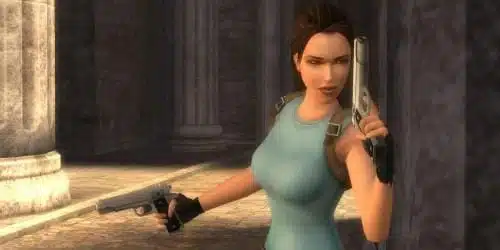
I had forgotten what a complicated woman Lara Croft was.
It has been 11 years since we first first began raiding tombs with the buxom and well bred Ms. Croft, and she has gone through a variety of iterations. The series is generally agreed to have declined as near-yearly retreads of tomb raiding grew a bit more action packed and a bit less cerebral than the original.
Indeed, action was not necessarily at the core of Lara’s first adventure, as her infamous dual pistols often remained holstered throughout more of an adventure that emphasized thoughtful and graceful movement and acrobatics than fighting and combat.
In fact, when the original Tomb Raider came onto the scene, it was hailed as adding new life to the ailing genre of the adventure (those old point and click games that largely resembled puzzle games wrapped within a rather linear narrative) because of its emphasis on puzzling out the manner in which Lara moved around environments rather than the combat systems that are often at the core of action games. What Tomb Raider managed to do was create a hybrid between the two genres that allowed older school puzzlers the chance to figure out the mechanics of manipulating and moving through space while letting newer twitch gamers also enjoy themselves with the occasional shootout and boss battle.
Oh, and, of course, there was Lara. Puzzles and shotgun blasts aside, Lara was also there as delicious eye candy to become, perhaps, the video game’s first legitimate, pixelated sex symbol.
In a note to the game’s fans available in its “Unockables” section in the new remake of the first Tomb Raider, Tomb Raider: Anniversary, Crystal Dynamics mentions that largely what they wanted to recapture in this revision of the original game was Tomb Raider‘s sense of “isolation.”
This note seems to me a perfectly apt way of describing the mood and tone of the original game and also emphasizes the very elements that I have mentioned thus far about Lara’s original adventure — both its emphasis on solving visual puzzles and watching the solitary Lara penetrate the depths of underground tombs. As my wife so succinctly put it to me the other day as she watched me play this remade version of Lara’s first exploration of the world’s tombs, “its like Myst with shorty shorts.”
She hit the nail on the head.
Lara reaches for a conveniently-placed post
Like the purer puzzle-based adventure Myst, Tomb Raider is a game about watching and observation. Viewing the landscape and then figuring out how to progress through it is a serene and nearly static process in both games. The beautiful panoramic scenery of the world of Myst is present in Tomb Raider, as is (generally) the opportunity to take time to study it and consider how to advance in it, given that Lara — as an isolated explorer in the tombs of the dead — is usually unharried by enemies and the fast frenetic energy that they require to respond to. But, what Tomb Raider adds to the voyeuristic subgenre of the puzzler is a little voyeuristic thrill due not simply to the aesthetics of a picturesque landscape, but also the aesthetics of a picturesque ass in khakis.
Lara’s body becomes the main visual cue for processing and executing puzzles that otherwise might have remained in a simplified abstract form. This notion was especially true of the original Tomb Raider, given the very precise nature of Lara’s locomotion. Lara’s original movement was, as some observed, more like moving a tank than a person. Moving Lara right and left simply pivoted her body in place, and thus she always moved in perfectly straight lines either forward or backward.
While gamers complained about this unnatural movement as the series advanced alongside other games that introduced the more natural movement physics of modern 3-D game characters, this more simplistic system had the elegance of an abstract puzzle game. The precision of this more mechanical motion allowed the player to worry less about precise reflexed movements and allowed the player instead to consider exactly how Lara-as-object would leap to the next ledge. The tank-like movements, in fact, made her motion more predictable, like the predictability of gauging the distance needed to slide blocks into place in a true puzzle game like Tetris. Thus, motion was not used as an action-oriented occupation but as a way of advancing a “piece” along a 3D board with the object of resolving the puzzle. Most often, the solution was getting your piece from point A to point B.
Tomb Raider was an advancement in the puzzle or adventure genre, as it simply gave the puzzle or adventure game enthusiast something more interesting to consider than an abstract shape. It gave them what was clearly a “piece.”
Tomb Raider Anniversary — rightly or wrongly — moves away from this format. Like last year’s Tomb Raider Legend, Lara’s movement has been “upgraded” to the more modern movement physics introduced in games like Super Mario 64, in which a left flick or right flick of an analog stick moves the character immediately right or left. Lara’s new movement feels more authentic and natural as it has been mordernized, but, while the game succeeds in recreating the isolated mood and tone of the original, it lacks some of the nostalgia for the original’s genre-blending conventions.
If Anniversary is intended to showcase the watershed nature of Lara’s original adventure in the history of video games (which, again, the note to the game’s fans suggests), this seemingly archaic element of Tomb Raider may be the cardinal omission of its translation. Lara’s abstracted motion may be the link between the past and future of action-adventure hybrid games and reveal in some sense why contemporary action-adventure games like God of War or Prince of Persia have leaned more toward fluid action and away from the isolated and serene aspects of the adventure that made Lara’s first foray so compelling.

